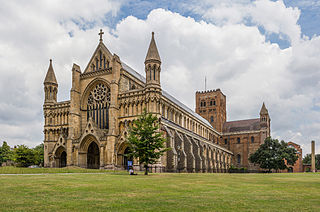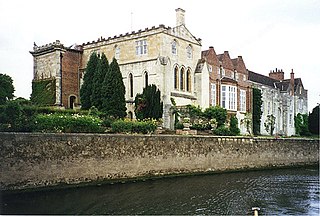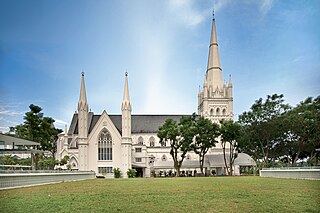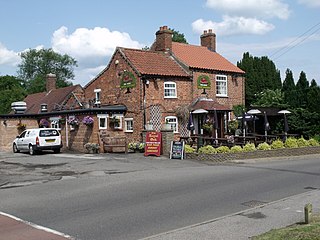
York Minster, formally the "Cathedral and Metropolitical Church of Saint Peter in York", is an Anglican cathedral in the city of York, North Yorkshire, England. The minster is the seat of the archbishop of York, the third-highest office of the Church of England, and is the mother church for the diocese of York and the province of York. It is administered by its dean and chapter. The minster is a Grade I listed building and a scheduled monument.

St Albans Cathedral, officially the Cathedral and Abbey Church of St Alban but often referred to locally as "the Abbey", is a Church of England cathedral in St Albans, England.

Bishopthorpe is a village and civil parish three miles south of York in the City of York unitary authority area and ceremonial county of North Yorkshire, England. Bishopthorpe is close to the River Ouse, and has a population of 3,174, increasing to 3,237 at the 2011 Census. The area of Main Street and the Palace were made a conservation area in 1989 along with other open areas of the village.

Bishopthorpe Palace is the official residence of the Archbishop of York at Bishopthorpe, North Yorkshire, England. The palace is located on the River Ouse and is approximately 3 miles (4.8 km) south of York, which is the location of the diocese's cathedral, York Minster.

The Church of St Mary the Virgin, widely known as St Mary Redcliffe, is the main Church of England parish church for the Redcliffe district of the city of Bristol, England. The first reference to a church on the site appears in 1158, with the present building dating from 1185 to 1872. The church is considered one of the country's finest and largest parish churches as well as an outstanding example of English Gothic architecture. The church is so large it is sometimes mistaken for Bristol Cathedral by tourists. The building has Grade I listed status, the highest possible category, by Historic England.

Saint Andrew's Cathedral is an Anglican cathedral in Singapore. It is located near City Hall, Downtown Core, within the Central Area in Singapore's central business district. It is the cathedral church of the Anglican Diocese of Singapore and serves as the mother church to 27 parishes and more than 55 congregations. The church has existed on the site since 1836, although the current building was constructed in 1856–1861. The logo of the cathedral is the St Andrew's Cross.

Aubourn is a small village in the civil parish of Aubourn with Haddington, in the North Kesteven district, in the county of Lincolnshire, England. It is just east of the A46, in between Lincoln and Newark-on-Trent. It has a one-way system that is unusual for a small countryside village, and a public house called 'The Royal Oak'. In 1921 the parish had a population of 212. On 1 April 1931 the parish was abolished to form "Aubourn, Haddington and South Hykeham".
Edmund Thomas Blacket was an Australian architect, best known for his designs for the University of Sydney, St. Andrew's Cathedral, Sydney and St. Saviour's Cathedral, Goulburn.

St Olave's Church, Old Jewry, sometimes known as Upwell Old Jewry, was a church in the City of London located between the street called Old Jewry and Ironmonger Lane. Destroyed in the Great Fire of London in 1666, the church was rebuilt by the office of Sir Christopher Wren. The church was demolished in 1887, except for the tower and west wall, which remain today.

The Sacred Heart Cultural Center, known also as Sacred Heart Catholic Church, is an events center and a former Catholic parish church located in Augusta, Georgia.

The medieval cathedrals of England, which date from between approximately 1040 and 1540, are a group of twenty-six buildings that constitute a major aspect of the country's artistic heritage and are among the most significant material symbols of Christianity. Though diverse in style, they are united by a common function. As cathedrals, each of these buildings serves as central church for an administrative region and houses the throne of a bishop. Each cathedral also serves as a regional centre and a focus of regional pride and affection.

St. Luke's Episcopal Church is located in Beacon, New York, United States. The church complex of four buildings and a cemetery takes up a 12-acre (4.9 ha) parcel between Wolcott, Rector, Phillips and Union Streets. It was founded in 1832 as a religious school that soon became St. Anna's Church of Fishkill Landing.

St Andrew the Apostle is an Anglican church in Worthing, West Sussex, England. Built between 1885 and 1886 in the Early English Gothic style by Sir Arthur Blomfield, "one of the last great Gothic revivalists", the church was embroiled in controversy as soon as it was founded. During a period of religious unrest in the town, theological tensions within Anglicanism between High church Anglo-Catholics and Low church Anglicans were inflamed by what the latter group saw as the church's "idolatrous" Roman Catholic-style fittings—in particular, a statue of the Virgin Mary which was seized upon by opponents as an example of a reversion to Catholic-style worship in the Church of England. The "Worthing Madonna" dispute delayed the consecration of the church by several years. English Heritage has listed the building at Grade C for its architectural and historical importance, and the adjacent vestry and vicarage are listed separately at Grade II.

St Mary's Church is a ruined redundant Anglican church in the civil parish of Tilney St Lawrence, Norfolk, England. It is recorded in the National Heritage List for England as a designated Grade II* listed building, and is under the care of the Churches Conservation Trust. The ruins stand in an isolated position adjacent to Islington Hall Farm, immediately to the south of the A47 road between King's Lynn and Wisbech.

St Luke's Anglican Church is a heritage-listed church at 152 Herries Street, Toowoomba City, Queensland, Australia. It is the second church on the site and was designed by John Hingeston Buckeridge and built in 1897. It is also known as St Luke's Church of England. It was added to the Queensland Heritage Register on 28 July 2000.

St Chad's Church, on Greengate Street in the centre of Stafford, is a Grade II* listed Anglican church. Saint Chad, who died in 672, was the first Bishop of Lichfield. The church was built in the 12th century, and is the oldest building in Stafford.

The Church of St Teresa of Avila in Everton Road, Birkdale, Southport, Sefton, Merseyside, England, is an active Roman Catholic church in the diocese of Liverpool. It was built in 1897–98 and designed by the architectural partnership of James Sinnott, Bernard Sinnott & Daniel Powell. The church, together with its attached presbytery, is recorded in the National Heritage List for England as a designated Grade II listed building.

St James Church is a heritage-listed Anglican church at 145 Mort Street, Toowoomba, Queensland, Australia. It was designed by Richard George Suter and built from 1869 to 1953. It is also known as St James Church of England. It was added to the Queensland Heritage Register on 28 July 2000.

Holy Trinity Church is a heritage-listed Anglican church at 141 Brookes Street, Fortitude Valley, City of Brisbane, Queensland, Australia. It is the second church on that site. It was designed by Francis Drummond Greville Stanley built from 1876 to 1877 by James Robinson. It was modified in 1920–1921, 1925 and 1929. It was added to the Queensland Heritage Register on 21 October 1992.

St Mary's Church is in Fernyhalgh Lane, Broughton, Lancashire, England. It is a Roman Catholic church located near the shrine at Ladyewell House. The church was built in 1792–94 to provide services for pilgrims when the chapel at the house became too small for the numbers attending. Attached to the east of the church is the presbytery, and both are built in red brick with sandstone dressings with slate roofs. Near the church is a school built in 1836, and later used for other purposes. Ladyewell House contains a 16th-century altar, relics and memorabilia, and in garden are a chapel and a holy well. The church and house are in active use for church services, pilgrimages, and visitors.


















